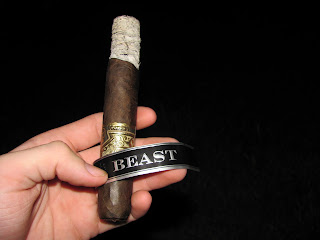Deus Vult! God wills it, and so as not to disappoint I have made the Ave Maria Crusader the next cigar I'll review. The Crusader, Ave Maria's appellation for their 5x52 robusto, is one of those special cigars that gave me a good feeling the moment I laid eyes on it. The Ecuadorian habano wrapper is well rolled with a few veins and was adorned with one of the most beautiful cigar band's I've ever come across. The band is trimmed in golden foil, and features a Templar Knight in full regalia. The pictures hardly do it justice, and it really is a wonder to behold. One of the most interesting features, and one I cannot claim credit for noticing, were the words "Deus Vult" raised out of one of the golden borders. My Latin being a bit rusty, a quick google search revealed that this was the rallying cry of Pope Urban II at the start of the first Crusade. Clearly the creators of Ave Maria put a lot of effort into the creation of this band, and it really makes for an enjoyable start to the smoking experience.
 |
The pre-light aromas are of rich, natural tobacco and a subtle nuttiness. On lighting my palate was greeted with medium bodied flavor with notes of oak and subtle spice. This was very pleasant, and was without any harshness. The first third was much the same, and as it rounded into the second, the spices mellowed out leaving the woody notes and rich tobacco goodness for the rest of the cigar. In the final third, the body slowly increased and the cigar finished out somewhere between medium and full-bodied. This was my second experience with this blend and honestly, this is definitely one that is worth multiple samplings.
 |
The smoke had a creamy mouth feel, and the finish, although not particularly long, was a pleasant one. I found that some of the nuances, such as the subtle spiciness in the first third, were easier detected if the smoke was allowed to linger longer on the palate. The draw was, in a word, perfection. I used a straight cutter, and the slightly longer than usual taper of the Crusader allowed for what I would consider ideal air flow. The burn was decent, although I did make a small correction to a wayward wrapper in the final third. This likely speaks more to my lack of attention to the burn than the cigar itself, but it is worth noting. The ash on this cigar was a nice light gray color and held on for about two to two and a half inches, which seems to be typical for this cigar.
 |
As for what to pair with this cigar, I went with a cup of medium bodied Colombian coffee, which complemented the woody notes of the cigar nicely. Another option I would like to explore would be a nice glass of Maker's Mark Bourbon. The warm notes of oak and the spiciness of the drink would complement this cigar nicely, and play upon its strengths.
This is one of those rare instances where the beauty of the cigar band accurately reflects the beauty of the cigar. At around seven dollars each these cigars are a steal, and quite frankly I would probably pay more for them if I had to. This is another one of those cigars I can see myself enjoying for years to come, so rather unsurprisingly a box of them may be in my near future. As always, enjoy your stogies!

























